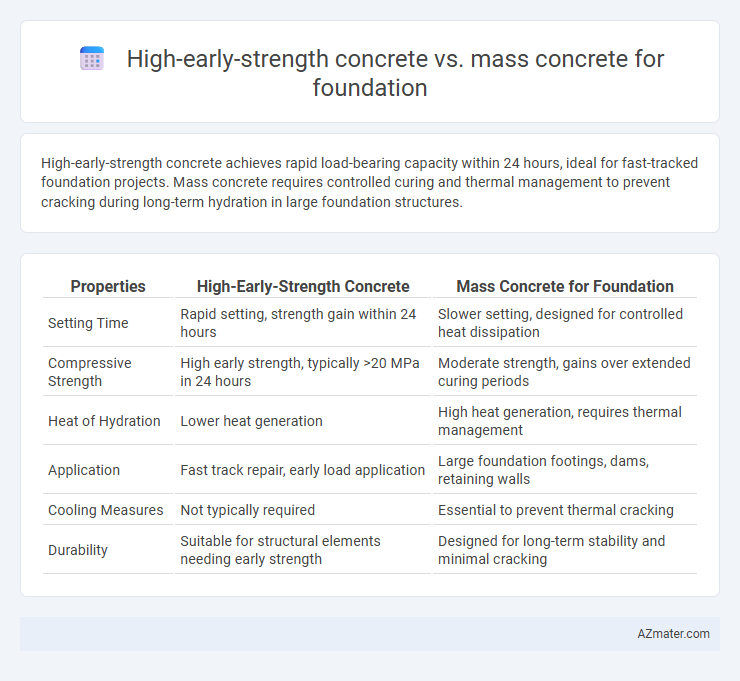High-early-strength concrete achieves rapid load-bearing capacity within 24 hours, ideal for fast-tracked foundation projects. Mass concrete requires controlled curing and thermal management to prevent cracking during long-term hydration in large foundation structures.
Table of Comparison
| Properties | High-Early-Strength Concrete | Mass Concrete for Foundation |
|---|---|---|
| Setting Time | Rapid setting, strength gain within 24 hours | Slower setting, designed for controlled heat dissipation |
| Compressive Strength | High early strength, typically >20 MPa in 24 hours | Moderate strength, gains over extended curing periods |
| Heat of Hydration | Lower heat generation | High heat generation, requires thermal management |
| Application | Fast track repair, early load application | Large foundation footings, dams, retaining walls |
| Cooling Measures | Not typically required | Essential to prevent thermal cracking |
| Durability | Suitable for structural elements needing early strength | Designed for long-term stability and minimal cracking |
Introduction to Foundation Concrete Types
High-early-strength concrete gains significant strength within hours, enabling faster construction schedules and early load application, ideal for rapid project timelines. Mass concrete, characterized by its large volume and slow heat dissipation, requires careful thermal control to prevent cracking and ensure structural integrity in massive foundation elements. Selecting the appropriate foundation concrete type depends on factors such as project speed, structural demands, and thermal management considerations.
Defining High-Early-Strength Concrete
High-early-strength concrete is a specialized mix designed to achieve compressive strengths exceeding 5,000 psi within 24 hours, enabling rapid construction progress and early load application. Unlike mass concrete, which emphasizes thermal control and volumetric stability for large-scale foundations, high-early-strength concrete incorporates high cement content and accelerators to expedite curing and structural integrity. This concrete variant is crucial for projects requiring quick formwork removal and fast turnaround times in foundation work.
Understanding Mass Concrete Characteristics
Mass concrete, characterized by its large volume and low surface area-to-volume ratio, undergoes significant internal temperature rise due to heat of hydration, necessitating careful thermal control to avoid cracking. High-early-strength concrete accelerates strength gain, reducing construction time but generates more heat, which can intensify thermal gradients in mass foundations. Understanding mass concrete properties such as thermal conductivity, heat capacity, and hydration kinetics is essential for optimizing mix design and ensuring structural integrity in large foundation applications.
Key Material Differences
High-early-strength concrete achieves rapid strength gain through a higher cement content and the use of accelerators, facilitating faster construction schedules for foundations. Mass concrete contains lower cement content with supplementary cementitious materials like fly ash or slag to reduce heat generation and shrinkage during curing, crucial for large-volume foundation pours. The primary material difference lies in the thermal management approach, where high-early-strength concrete prioritizes early load-bearing capacity while mass concrete focuses on controlling hydration heat to prevent cracking.
Setting Time and Curing Requirements
High-early-strength concrete achieves initial set within 3-6 hours, enabling faster load application and reducing construction time, while mass concrete typically has a slower setting time of 6-12 hours due to its larger volume and lower heat dissipation rate. Curing requirements for high-early-strength concrete involve maintaining moisture and temperature control for at least 3 days to ensure early strength gain, whereas mass concrete demands extended curing periods spanning 7-28 days to manage internal temperature rise and minimize thermal cracking. Proper curing in mass concrete incorporates cooling methods like embedded pipes or water spraying to control hydration heat, contrasting with the less intensive moisture retention needed for high-early-strength mixes.
Load-Bearing Capacity Comparison
High-early-strength concrete achieves rapid strength gain within 24 to 72 hours, enabling faster load application and reducing construction time for foundations. Mass concrete, characterized by large volumes and slower curing processes, presents challenges in heat dissipation that can impact uniform strength development and long-term load-bearing capacity. Studies indicate high-early-strength concrete foundations typically outperform mass concrete in early load-bearing capacity, providing enhanced structural stability during critical construction phases.
Thermal Considerations and Heat of Hydration
High-early-strength concrete generates significant heat rapidly due to its accelerated hydration process, increasing the risk of thermal cracking in foundations if not properly managed. In contrast, mass concrete, used in large volume pours, experiences prolonged heat evolution, necessitating temperature control measures like cooling pipes or insulation to prevent differential thermal stresses. Effective thermal management in both types is critical to maintaining structural integrity and preventing long-term foundation damage.
Cost Implications and Project Budgets
High-early-strength concrete accelerates construction schedules by achieving rapid load-bearing capacity, reducing labor and formwork costs, but its material costs are higher compared to conventional mixes used in mass concrete. Mass concrete, typically less expensive per cubic meter, requires longer curing times and extensive thermal control measures to prevent cracking, increasing overall labor and monitoring expenses within project budgets. Choosing between these concretes involves balancing upfront material costs against potential savings in project duration and long-term structural integrity expenses.
Durability and Long-Term Performance
High-early-strength concrete offers accelerated curing and early load-bearing capacity, which reduces construction time but may present higher shrinkage and potential cracking risks affecting long-term durability. Mass concrete, designed for large volumes with controlled heat of hydration, ensures reduced thermal gradients and minimized cracking, enhancing long-term stability and resistance to environmental stressors. For foundation applications, mass concrete's ability to maintain structural integrity over decades generally provides superior durability compared to high-early-strength concrete, especially in massive structures subjected to variable loads and moisture exposure.
Best Applications: Choosing the Right Concrete for Your Foundation
High-early-strength concrete is ideal for foundations requiring rapid load-bearing capacity, such as in fast-track construction projects or cold weather conditions where quick setting reduces downtime. Mass concrete is best suited for large structural foundations where thermal cracking due to heat of hydration must be controlled, making it essential for dams and large footings. Selecting the right concrete involves balancing early strength needs against thermal management and structural scale to ensure foundation durability and performance.

Infographic: High-early-strength concrete vs Mass concrete for Foundation
 azmater.com
azmater.com